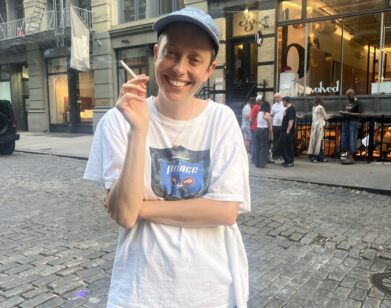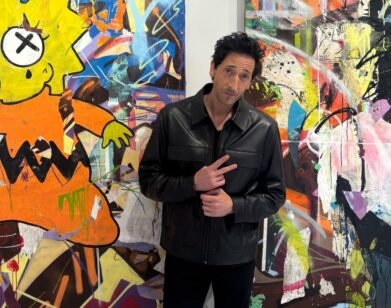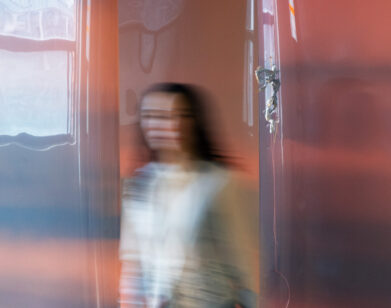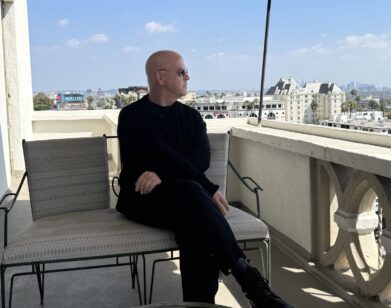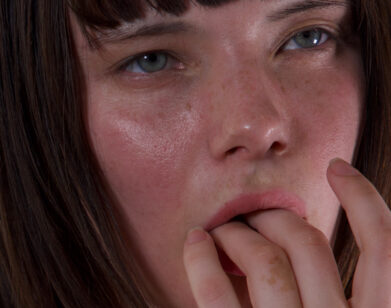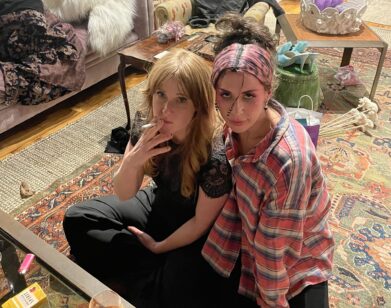Benjamin Patterson, Ears Open
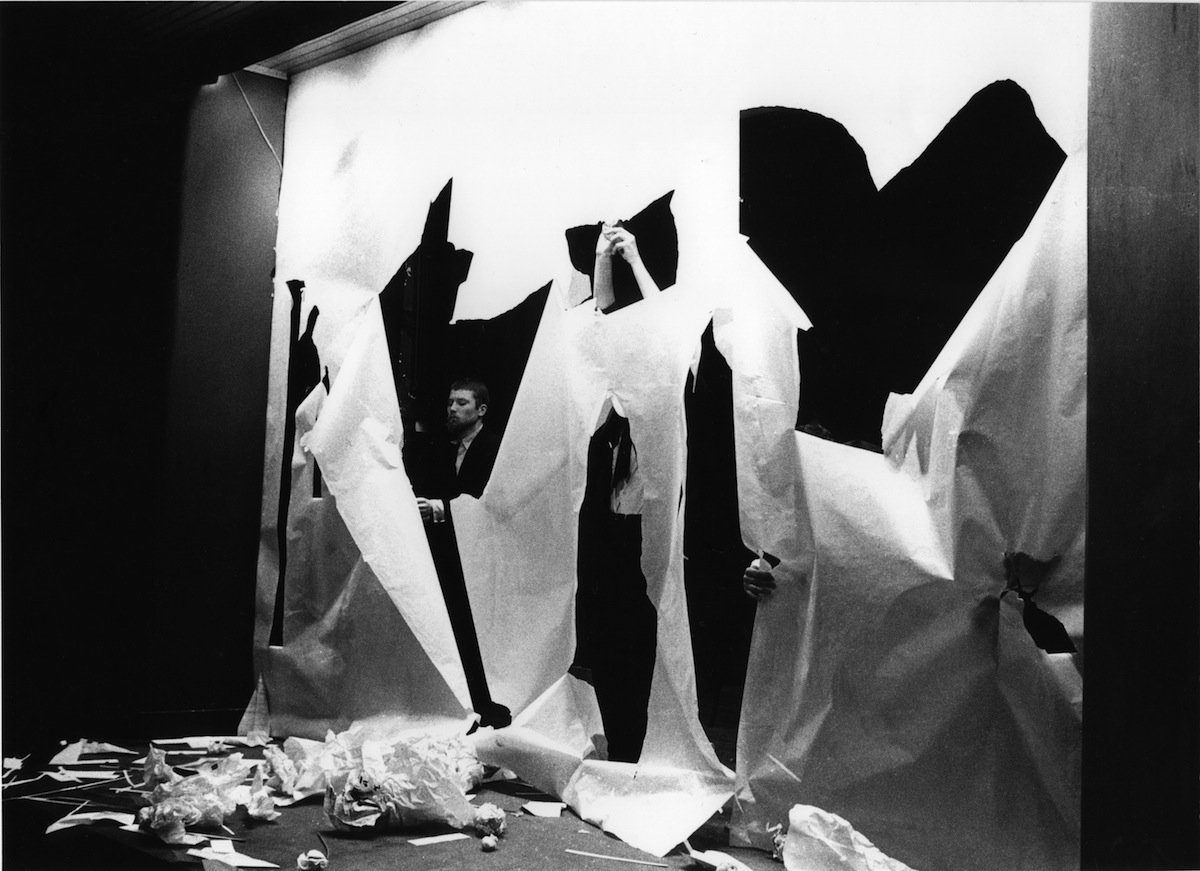
ABOVE: A SHOT FROM BENJAMIN PATTERSON’S PAPER PIECE
As a founding father of the Fluxus movement, Benjamin Patterson was an integral member of the international group of artists, who in the 1960s began blending various mediums and artistic disciplines. Music overlapped with literature, visual art with urban planning; avant-garde performances began spilling into the streets.
Patterson’s own artistic career spans over 50 years. Within that time, the classically trained double-bassist both retired and came out of retirement, never ceasing to create new pieces of art. “I tried to project this physical, athletic aspect of performance into the music,” Patterson says. He creates new scores, but also reimagines classical music to redirect the viewer’s attention.
While he was born in Pittsburgh, the performance artist now resides in Wiesbaden, Germany—the original Fluxus hotbed. In 1962, the first Fluxus festivals were held in this southwest German city, and a museum honoring the movement is located there today. Before his return to the U.S. for three upcoming performances during Performa 13, we spoke with Patterson over the phone about the evolution of his art and Fluxus’ lasting impact. Don’t expect another retirement: “I say artists are like old cowboys; they die with their boots on,” Patterson says, laughing. “I hope to continue until the last day. I certainly have no intentions to sit on the sofa and watch television for 10 hours a day.”
EMILY MCDERMOTT: I know you’re well known for Paper Piece and Lick Piece. What made you choose to perform Pond and A Penny for Your Thoughts opposed to your other works?
PATTERSON: Paper Piece will be an encore [at Roulette] and Lick Piece has been converted to something I call Tristan and Isolde. The Penny for Your Thoughts was a request from Valerie Cassel Oliver, and I like both. Penny for Your Thoughts is the old American expression. The way I realize that is with humor. It makes you think about how you think and what causes you to think about this, that, or the other thing. It’s a very simple piece, and it’s a one-on-one. I buy thoughts from individuals that come to the booth and sell them new thoughts. It’s like a street vendor.
MCDERMOTT: What’s one of the craziest thoughts you’ve ever received?
PATTERSON: I should have saved some of them! [laughs] A lot of them have to do with relationships. “I think I’d like to meet this person,” or “I think I’d like to get this person out of my life.” These are thoughts people want to get rid of, so I buy them and get rid of them. They go in the garbage.
MCDERMOTT: That’s an easy way to dispose of thoughts. In Pond, you lay out a grid…
PATTERSON: Pond was one of the early pieces where I tried to use chance operations, like the John Cage school of thought, but in a different way. I like the mechanical frogs hopping about this grid, because they are not perfect. They move in different directions and create their own situation. Depending on where they land or as they pass through the grid, there are signals for the performers to make frog-like sounds. In the end, it sounds like a pond at nighttime with frogs croaking and creeping.
MCDERMOTT: I know your pieces are part of “Radical Presence,” the exhibition at the Grey Art Gallery and Studio Museum. To you, what does “radical presence” mean?
PATTERSON: It’s about Afro-American performance art, but I have not seen very much because I’ve been out of the States for 20 years. When I was living there, up until the beginning of the 1990s, there were very few other Afro-American performance artists. In some senses, you could say it’s radical because it’s unexpected. There is a lot of extreme work being performed— extreme in a sense of use of the body and exertion. Performance art has become an institution now; it’s an established medium, but I think it came to the African American art scene rather late. Perhaps that suggests radical presence.
MCDERMOTT: When you started performing, you were one of the first people to combine music with composition and this extreme body movement. How did that feel?
PATTERSON: I thought of it as expanded music. As a professional musician and bass player, the act of performing on the instrument is a very athletic exercise. That applies to pianists and every instrument where the body is involved with producing the sound. I found that the physical involvement, the kinetic energy that you put out, was almost as enjoyable as the actual sounds you produced. I felt that was something the audience was missing and something you don’t experience with a record.
MCDERMOTT: What led you start including the toys and props?
PATTERSON: One of the first pieces I did with the chance operations of nature was a work, which I called Ants. In the backyard of a house in Germany in 1960, I gathered up a bunch of ants. I dropped them in a clump on a large piece of white paper and then photographed their positions every 30 seconds. That became the basis for producing a score. A lot of my youth was spent with nature. We lived outside of Pittsburgh in a rural area and I spent a lot of time in summer camps, with Boy Scouts, and was a volunteer with the Pittsburgh Zoo. Animals and nature have always been very integral parts of my life.
MCDERMOTT: So nature and music are major influences, but where else did you draw inspiration?
PATTERSON: I think the two basic influences were music and nature, but I was always very curious about the sciences. Psychology has always interested me in one way or the other—how people behave. [laughs]
MCDERMOTT: Yeah, that’s reflected in Penny for Your Thoughts. After these earlier artworks, you decided to retire to lead a “normal life?”
PATTERSON: Family was coming along, and papa needed to earn money. If any Fluxus works were being sold at that point, it was for a penny or dollar per piece, so there was not much money to be made. I maintained my interest and followed what was going on, and from time to time would create small pieces, but it wasn’t a full-time occupation. Eventually [my] children grew up, finished university, and then it was possible to devote 100 percent of my time to artwork again.
MCDERMOTT: What were some of the changes you saw when you re-entered the world as a full-time artist?
PATTERSON: My coming-out-of-retirement event—a solo exhibition of objects and visual art at the Emily Harvey Gallery—was the first exhibition I had ever done of visual work. That was a big difference as opposed to before, which had been 99 percent performance work. Since then both performance and visual have continued. The visual work has gone as far as me becoming what you might call a Fluxus architect. I was commissioned to design a pavilion for the 50th Anniversary of Fluxus event in Wiesbaden in 2012 and now a Fluxus café/bar in a museum in Northern Germany. It keeps expanding.
MCDERMOTT: How do you think Fluxus is still alive?
PATTERSON: The influence of Fluxus is certainly still alive today. When we first made events and performances at festivals in 1962, there wasn’t a word to describe what were doing. The word “performance art” hadn’t been invented and we thought, for lack of a better description, that it was new, new music. Now every art school that thinks anything of itself has a department of performance art. [Performance art] is not only a medium Fluxus invented, but is also now taken as an established medium throughout the world. In many ways the spirit of Fluxus—intermedia work, exploring different media for artistic purposes—is well established. Even if the majority of original Fluxus artists are dead, the spirit is still there with this legacy of creating new mediums for making art. I would say anyone doing performance or video art today has been touched by Fluxus.
MCDERMOTT: As a performance artist, do you ever find it difficult to separate daily life from performance?
PATTERSON: Fluxus was about making art life and life as art. One of my Fluxus buddies said something, which was very to the point: “If you can’t tell the difference between art and life, I feel sorry for you.” So no. I have no problem separating the work and personal life. Each influences the other, but I don’t see them as containing each other. I take aspects of life and use it to make art, but that’s different.
MCDERMOTT: Yeah, that’s very different. Do you see a difference in responses when you perform Pond now versus when you originally performed it?
PATTERSON: Yes and no. I think back to the first festivals here in Wiesbaden. The older people who came to the concerts were very disturbed, but the younger people had a lot of fun. You still see a bit of that today, although it’s much less. A month ago I was asked to lecture to the Rotary Club of Wiesbaden. [laughs] The Rotary Club back then would have liked to have tarred and feathered us and thrown us in the Rhine River. There’s an acceptance now. Whether they really like it or not, they feel they have to know something about it and can’t dismiss it.
MCDERMOTT: There’s definitely been a generational shift of accepting performance art. What kind of music do you take into consideration when you’re making pieces?
PATTERSON: Most of the works where I use music of other composers have been from the classic tradition. You might call them spoofs, but I call them transformations. There’s a series of works, which I call The Three Operas, and it begins with Carmen, then there’s [Madame] Butterfly and Tristan and Isolde. So that’s Bizet, Puccini, and Wagner. I cover pretty broad spreads.
MCDERMOTT: What’s your process of seeing them as a source of inspiration and then creating something new?
PATTERSON: I do a Reader’s Digest of the things, in which I save only the best parts—a summation of the music and then a theatrical scenario underneath or on top. On the surface, it doesn’t seem to have much to do with the original theme of the opera, but it works and has been very successful. Exactly what holds it together is difficult to say, except that we call it art. You call things like these three operas war horses, because everybody does them. You barely hear the music because you know it so well; it’s like wallpaper. My digesting and transformation of the works open your ears again to the original music.
MCDERMOTT: What is your philosophy toward art?
PATTERSON: I’ve never sat down to write out a manifesto. I don’t believe in manifestos. [laughs] What I try to do is open people’s minds, ears, and eyes, not necessarily with shock technique, but with surprises and unexpected things so they become more aware and sensitive to the world around them. It would be good if you could say that art creates peace and prevents wars, but I’m not sure that happens. But I think it’s possible that by making people more sensitive to their surroundings and fellow humans that life can be a little less chaotic. Perhaps it’s better to say the work is about trying to find order within chaos.
BENJAMIN PATTERSON WILL PERFORM THREE PIECES AS PART OF PERFORMA 13, STARTING WITH ACTION AS COMPOSITION: A RETROSPECTIVE CONCERT TONIGHT AND CONTINUING WITH POND AND A PENNY FOR YOUR THOUGHTS THIS SATURDAY, NOVEMBER 16. FOR MORE INFORMATION, PLEASE VISIT PERFORMA’S WEBSITE.

